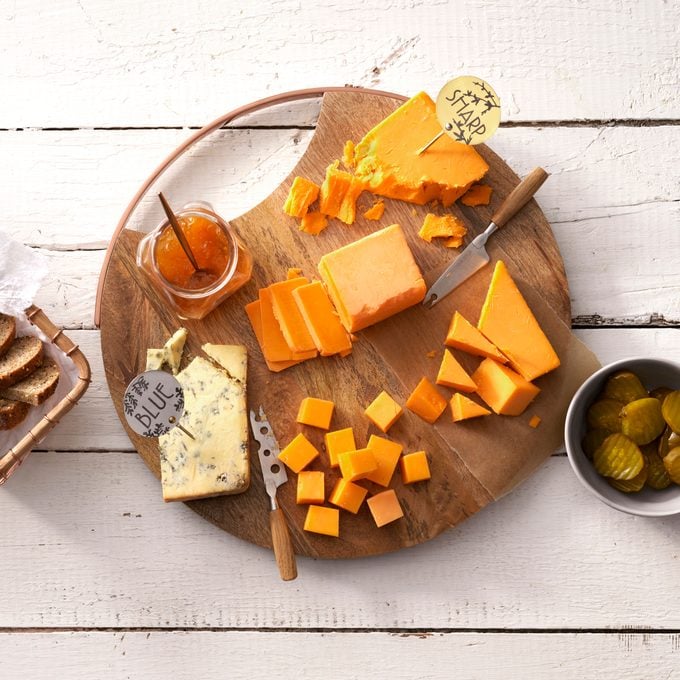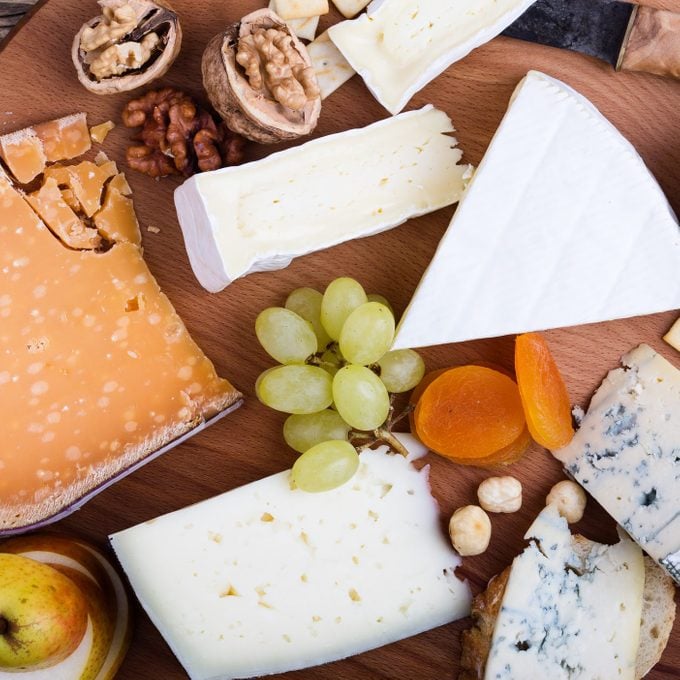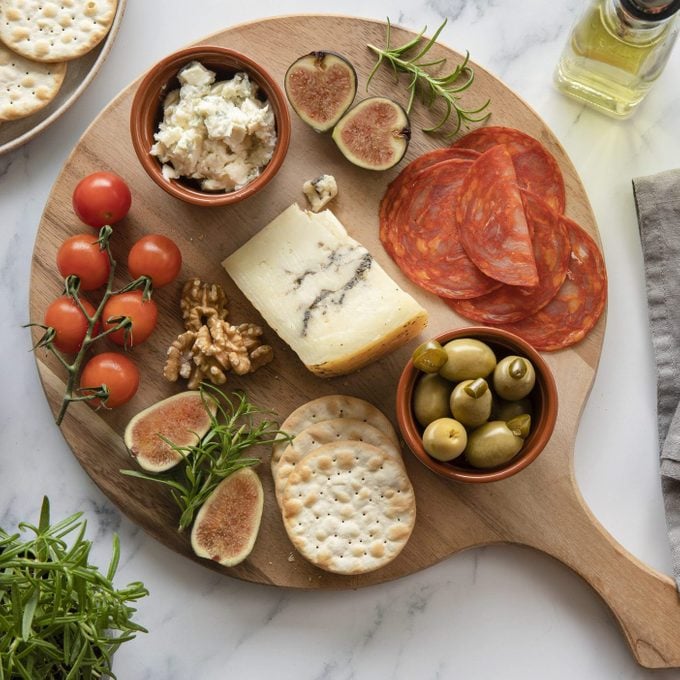Our Test Kitchen experts share their best tips on pairing cheese for charcuterie boards.
Our editors and experts handpick every product we feature. We may earn a commission from your purchases.Learn more.
Our Test Kitchen experts share their best tips on pairing cheese for charcuterie boards.
Our editors and experts handpick every product we feature. We may earn a commission from your purchases.Learn more.
Love having guests over, but don’t have time to make one of our easy potluck dishes? Your secret weapon will be a cheese board. Before you conjure images of your mother’s sliced cheddar cheese on a simple plate—think again. What we’re going to show you is nothing like that! With cheese board ideas and tips from our experts, you’re steps away from crafting a cheese board masterpiece filled with bold flavors.

Before we get to the good stuff, it’s best to confirm your guest list first. Why? Cheese can be expensive and you don’t want to overbuy. Plan on serving about 3-4 ounces of cheese per guest (that’s 2 pounds for eight guests).
Editor’s Tip: For most hard cheeses, a single ounce is roughly the size of a pair of dice.

With so many types of cheese, it’s easy to get overwhelmed. Most grocery stores have a cheesemonger (yes, that’s a real title) who is an expert on cheese varieties, colors, textures and tastes. Don’t be shy! They’ll probably be delighted to answer your questions.
Cheese for charcuterie boards should be varied. Choose at least one cheese from each of the following categories: soft, semi-soft, firm, blue and aged. Don’t be afraid to include some of your personal favorites. After all, you’re buying! Consider your crowd as you make your choices as well. You may want to get adventurous and introduce them to new options, or stick with the classics. Make sure to check out our favorite charcuterie board books to inspire your next soiree.
Psst! If you’d like to skip all the prep, opt for a charcuterie box instead.
Our recommendations: Goat cheese, Brie, Camembert, feta
Few people will pass up a good goat cheese. It’s creamy, tart and mild in flavor. You can roll it in chopped herbs for color or nuts for texture. Camembert or Brie are good focal points for your board because they come in small wheels. They have earthy notes and you can eat the rind. Another flavorful soft cheese? Feta; it’s a great salty, tangy option.
Pairs well with: Fruits. For soft cheeses like goat cheese, Brie and Camembert, think of things like stone fruits (peaches, apricots and figs) and sliced pears and apples. Spreads like blackberry and raspberry preservers also lend a sweet touch to these cheeses. Feta pairings look a bit different. Think of fruits like watermelon and cantaloupe or cucumbers and tomatoes. Olives also work very nicely with feta.
Our recommendations: Mozzarella, burrata, Havarti
Mozzarella is a crowd-pleasing Italian cheese that’s mild in flavor (here are the Taste of Home Test Kitchen’s picks for the best mozzarella). What’s more, it comes in many shapes and sizes to help you add visual interest to your board—look for mozzarella balls, braids and sticks. If you love mozz, try burrata cheese. It’s essentially mozzarella formed into a pouch with soft curd on the interior, so you get a good combination of textures.
Not interested in mozzarella? Havarti has a sharp flavor but a creamy, soft texture to pair with just about anything. Get creative with these individual charcuterie boards for any occasion.
Pairs well with: Meats and fruits. For cheeses like mozzarella and burrata, try pairings like salty prosciutto, marinated tomatoes or cantaloupe. A fresh herb like basil or greens like arugula also lend slightly peppery notes to these semi-soft cheeses. Accompaniments for Havarti include soppressata, apple slices and figs.
Our recommendations: Asiago, Manchego, Gruyere
Asiago is mild in flavor and gets harder and crumbly as it ages. It tastes similar to Parmesan. If Asiago isn’t your thing, Manchego might be a good option. It’s a nutty, buttery, aged sheep’s milk cheese. It also has a distinctive herringbone pattern pressed into the rind (which, by the way, is not edible). Another great choice? Gruyere offers a delicious nutty, slightly sweet taste.
Pairs well with: Fruits and meats. Opt for figs, grapes or sun-dried tomatoes for cheeses like Asiago and Manchego. While meats like ham and salami would go well with Asiago, these two meats will definitely give Gruyere cheese a delightful salty bite.
Our recommendations: Stilton, Gorgonzola, cheddar blue
When it comes to blue cheese, most people either love it or hate it. In all honesty, it took me some time to come around to this one. Blue cheese is pungent and tastes sharp and salty, with blue veins. You’ll know it when you see it—or smell it! Not a fan of the super-strong blue cheeses? Cheddar blue is a hybrid, offering a more mellow option.
Pairs well with: Dried fruits. Because blue cheeses are often pungent, it’s best to stick with the simple flavors of dried fruits, or mild slices of apples.
Our recommendations: Sharp cheddar, white cheddar, Gouda
For the most part, cheese gets tangier and more intense as it ages. Over time, cheddar develops an irresistible flaky texture, which is why I tend to keep it on my cheese board. Aged white cheddar and gouda are good options, too. To really amp up the flavor, consider a smoked gouda as well.
Pairs well with: Meats. The salty varieties of salami accompany the intense flavors of aged cheeses like cheddar and Gouda so well. Try peppered salami for even more intense flavor, or keep it classic with thick cut Genoa salami.
Need more inspiration? Explore lesser-known cheese options and find a new favorite by joining one of these cheese of the month clubs.

Now it’s time to select all the extra items that’ll accompany your cheese for a charcuterie board. Besides the cured meats and fruits that we recommended above, you’ll want to complete your cheese board with nuts, spreads and crackers too. Include a variety of colors, shapes and textures and a mix of sweet and savory flavors. Here are a few ideas to consider:
If you have time to make a few homemade items for your cheese board, try this recipe for Gentleman’s Whiskey Bacon Jam—it’s the perfect combination of sweet and savory. Caramelized Onion Jam is another crowd-pleaser. Also check out our cheese board pairings for more inspiration.
Don’t miss our tips for how to make a charcuterie board perfect for any party.
There’s no wrong way to assemble a cheese board, but we do have a few tricks to help guide you.
Start by placing your cheeses on your board first. Spread them out to serve as focal points you’ll build from. If you’re incorporating items served in bowls and jars (such as mixed nuts or Roasted Red Pepper Tapenade), add those next. Once you’ve created your base, arrange the meats. Then, fill in the gaps with breads, crackers, nuts and fruits, adding them according to size, largest to smallest. (Psst! These mini jam jars might be a great addition to your cheese board, too).
Don’t forget any utensils you might need, including the right cheese knives. As a final touch, add a few garnishes such as sprigs of rosemary or thyme.
Editor’s Tip: It may be tempting, but don’t top your cheeses with anything. Let your guests taste the cheese on its own and with the different accompaniments to discover which combinations they like best.
The hard work is over. It’s time to eat some cheese! And what goes well with cheese? A glass of wine or a glass of bubbly. Follow our guide to food and drink pairing for more inspiration.
When it comes to cheese board ideas, it’s all about embracing your creativity to put together a delicious spread. Here are a few things to keep in mind:
Hosting family and friends for the holidays? Put together a festive holiday cheese board or cozy up for a night of Christmas movies with a sweet hot chocolate board.
Up Next: How to make the best breakfast charcuterie board.